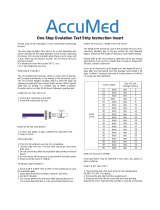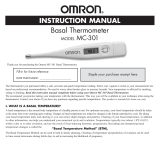Page is loading ...

LH Ovulation Rapid Test Dipstick (Urine)
Package Insert
For Self-testing
REF FLH-U101H
English
【INTENDED USE】
The LH Ovulation Rapid Test Dipstick (Urine) is a rapid chromatographic immunoassay for
the qualitative detection of human luteinizing hormone (hLH) in urine to aid in the detection of
ovulation. The result can be read visually in minutes to indicate a positive or negative result
for ovulation.
【SUMMARY】
Ovulation is the release of an egg from the ovary. The egg then passes into the fallopian tube
where it is ready to be fertilized. In order for pregnancy to occur, the egg must be fertilized by
sperm within 24 hours after its release. Immediately prior to ovulation, the body produces a
large amount of human luteinizing hormone (hLH) which triggers the release of a ripened egg
from the ovary. This “hLH surge” usually takes place in the middle of the menstrual cycle.1
The LH Ovulation Rapid Test Dipstick (Urine) is a complete system to help predict the time of
ovulation, and peak fertility. It is during this fertile time that pregnancy is most likely to occur.
The LH Ovulation Rapid Test Dipstick (Urine) detects the hLH surge in urine, signaling that
ovulation is likely to occur in the next 24-36 hours. Important: The hLH surge and ovulation
may not occur in all menstrual cycles.
【PRINCIPLE】
The LH Ovulation Test is a rapid lateral flow immunoassay for the qualitative detection of hLH
surges in urine, signaling that ovulation is likely to occur in the next 24-36 hours. The test
utilizes a combination of antibodies including a monoclonal hLH antibody to selectively detect
elevated levels of hLH.
The urine sample moves forward laterally on the test due to capillary forces. In the presence
of hLH an immunological reaction between hLH and labeled anti-hLH antibodies takes place
leading to a distinct red colored test line. Depending on the hLH concentration, the test line
becomes lighter or darker. Other labeled antibodies from the control line. This reaction serves
as a proof for the proper use and function of the test strip. This methodology is named
immunochromatography.
【SPECIMEN COLLECTION AND PREPARATION】
• Determine the optimal time for urine collection. For best results, collect urine at about the
same time each day. Some women have found that their best specimen is after 12 noon.
Do not collect the first urine specimen after waking up.
• Reduce liquid intake approximately 2 hours prior to urine collection.
• Record the date, cycle day and time of urine collection. See the TEST RESULTS CHART
at the end of this package insert.
• Use a new specimen collection container for every sample.
• Urine can be stored at room temperature for up to 8 hours or at 2-8°C for up to 24 hours.
Do not freeze. For best results, test urine on the same day that it is collected. If
refrigerated, let urine reach room temperature before testing. Do not shake the container.
If a sediment forms at the bottom of the collection container, allow the sediment to settle.
Use only urine from the top of the container.
【PRECAUTIONS】
Please read all the information in this package insert before performing the test.
Do not use after the expiration date printed on the foil pouch.
Do not use if pouch is torn or damaged.
Store in a dry place at 2-30°C or 36-86°F. Do not freeze.
Keep out of the reach of children.
Do not open the test foil pouch until you are ready to start the test.
For in vitro diagnostic use. Not to be taken internally.
The used test can be disposed off in normal household waste.
For single use only.
【STORAGE】
The test kit has to be stored at temperatures between +2 and +30°C until the expiry date. The
foil pouch has to be kept closed until immediately before use. Avoid exposure to direct
sunlight, humidity or heat.
【MATERIALS】
Materials provided: 1. Test Dipsticks; 2. Package Insert;
Materials required but not provided: 1. Specimen collection container; 2. Timer
【INSTRUCTIONS】
WHEN TO START TESTING
This kit contains 5 tests, allowing you to test over several days to find your most fertile time.
Calculate when to start testing using the chart below.
1) First, determine your Menstrual Cycle Length. Your Menstrual Cycle Length is the
number of days from the first day of your period (menstrual bleeding) to the last day
before the next period starts.
2) Next, determine the Days to Count Ahead after the period to start testing. Find the
menstrual cycle length on the first row of the chart below, and read the corresponding
number in the second row. This is the number of days after your period to begin testing.
3) See the Example and Sample Calendar below to determine which day you should begin
testing. First morning urine should NOT be used when testing for LH. For best results,
you should test around the same time each day. You should reduce your liquid intake
approximately 2 hours prior to testing.
When to Start Testing Chart
Menstrual Cycle
Length
21
22
23
24
25
26
27
28
29
30
31
32
33
34
35
36
37
38
Days to Count
Ahead
6
6
7
7
8
9
10
11
12
13
14
15
16
17
18
19
20
21
Example: My usual cycle length is 28 days. My last period started on the 3rd. The “When to
Start Testing Chart” shows that I will count ahead 11 days beginning with the 3rd. When I
count 11 days ahead on the calendar, I find that I will collect and test my urine starting on the
13th.
Sample Calendar
S
M
T
W
T
F
S
1
2
③
4
5
6
7
8
9
10
11
12
13
14
15
16
17
18
19
20
21
22
23
24
25
26
27
28
29
30
31
○First day of the last period
Begin testing with the LH Ovulation Test
【DIRECTIONS FOR USE】
Determine the day you will begin testing using the “When to Start Testing Chart”. A timer is
needed to perform the test (not supplied).
1. Allow the test and urine specimen to reach room temperature (15-30°C) prior to testing.
2. Bring the pouch to room temperature before opening it. Remove the Dipstick test from the
sealed pouch and use it within one hour.
3. With arrows pointing toward the urine specimen, immerse the test dipstick vertically in the
urine specimen for at least 10-15 seconds. Do not pass the maximum line (MAX) on the
test dipstick when immersing the dipstick. See illustration below.
4. Place the test dipstick on a clean, dry, non-absorbent flat surface, start the timer and wait
for the colored line(s) to appear. Read results at 5 minutes. Do not interpret the result after
10 minutes. The used test can be disposed off in normal household waste.
【READING THE RESULTS】
(Please refer to the illustration)
POSITIVE: Two lines are visible and the line in test line region (T) is the same as or darker
than the line in the control line region (C). This indicates probable ovulation in 24-36 hours.
NEGATIVE: Two lines are visible, but the line in the test line region (T) is lighter than the line
in the control line region (C), or there is no line in the test line region (T). This indicates that no
hLH surge has been detected.
INVALID: Control line fails to appear. Insufficient specimen volume or incorrect procedural
techniques are the most likely reasons for control line failure. Review the procedure and
repeat the test with a new test. If the problem persists, discontinue using the test kit
immediately and contact your local distributor.
【LIMITATIONS】
1. For self-testing in vitro diagnostic use
2. This test may not be used as a form of birth control.
3. Do not reuse the dipsticks
4. The test results should not be affected by pain relievers, antibiotics and other common
drugs. Medication containing hCG or hLH may affect the test and should not be taken while
using the LH Ovulation Rapid Test Dipstick (Urine). In addition, the test will not work
properly for subjects who are pregnant, in menopause, or taking birth control pills.
5. Keep out of the reach of children.
【EXTRA INFORMATIONS】
1、 Q: When can I do the test?
A: After you determine the best day to start testing based on your monthly cycle, you
can do the test any time on that day. Testing with first morning urine is not
recommended because it is concentrated and may give a false positive result. Testing
between 10:00 AM and 8:00 PM is a good timeframe, with many REs suggesting testing
at 10:00 AM. Test at about the same time each day. Reduce your liquid intake for 2
hours before testing.
2、 Q: Can I use the LH Ovulation Test to avoid pregnancy?
A: No, the test should not be used as a form of birth control.
3、 Q: How accurate is the LH Ovulation Test?
A: A clinical evaluation was conducted comparing the results obtained using the LH
Ovulation Test to another commercially available urine membrane LH test. The in-house
clinical trial included 300 urine specimens. The results demonstrated >99.9% specificity
and >99.9% sensitivity with an overall accuracy of >99.9%.
4、 Q: What if no line appears in the Control region?
A: If no line appears in the Control region after 5 minutes, the result is invalid and you
should repeat the test with anew test. If the problem persists, please contact the
manufacturer.
5、 Q: I have tested for several days and I did not see a surge. What do I do?
A: Since every woman does not always ovulate at mid-cycle, you may not detect the
hLH surge in the first seven days of testing. This could mean you have not ovulated yet
and you should continue testing with an additional LH Test.
6、 Q: I have tested for 8 days or more and I still did not see my hLH surge, what is
wrong?
A: About 90% of ovulating women with regular cycles will see their surge during 8–10
days of testing. If you do not, it could mean that you have not ovulated this month. If you
are having a short cycle this month, it is possible that you have ovulated before you
started testing. If you are having a long cycle this month, you may not have ovulated yet.
You may continue testing or test again next month. Don't worry; it is normal to have an
occasional short or long cycle, or to have a cycle without ovulating.
7、 Q:I have used the ovulation test for three months, and each month I have seen a
surge and have had intercourse that day or night. I have not become pregnant yet.
What is wrong?
A: First, it is important to remember that it can take normal, healthy couples many
months to become pregnant. There are many factors that can affect your ability to
become pregnant even if you have been able to have intercourse during your most
fertile days. If after several months you have no success, consult with your physician or
health care provider.
8、 Q: What could interfere with my test result?
A: if you are already pregnant, have recently been pregnant, or have reached
menopause you may get a misleading result. Some prescription drugs, such as
menotropins for injection and Danazol may affect the results you see. Please consult
your physician if you have any questions about prescription drug interactions.
9、 Q: Will oral contraceptives affect the result?
A: After using the pill your cycle may be irregular and may take some time to stabilize
again. You may wish to wait until you have had two normal periods before starting to use
the Test.
10、 Q: If the Test can determine my most fertile time, why can't I use it for
contraception?
A:Sperm can survive up to 72 hours, and this test predicts your hLH surge only up to 24
to 36 hours in advance. Therefore, if you have intercourse before you discover your
surge, the egg can still be fertilized.
11、 Q: How sensitive is the LH Ovulation Test?
A: The LH Ovulation Test detects human luteinizing hormone (hLH) in urine at
concentrations of 30 mIU/mL or higher. Standard control calibrator use WHO NIBSC
code: 80/552. The addition of FSH (1,000 mIU/mL), hCG (10,000 mIU/mL), and TSH
(1,000 µIU/mL) to negative (0 mIU/mL hLH) and positive (30mIU/mL hLH) specimens
showed no cross-reactivity.
12、 Q: Do alcohol or common medications affect the test?
A: No, but you should consult your physician if you are taking any hormonal medication.
Also, recent oral contraceptive use, breastfeeding, or pregnancy could affect the test
results.
13、 Q: How long will the lines remain visible?
A: The test should be read at 3 minutes for best results. A positive (Surge) result will
never disappear. The colored line(s) may become darker and a tinted background may
appear after several hours. Some negative results may later display a faint second color
line because of evaporation from the test line. Therefore, you should not read the results
after 10 minutes; discard the test once you have read the result.
14、 Q: I am now using the basal body temperature method (BBT). Does this test
replace BBT?
A: The LH Ovulation Test does not replace the BBT method. The shift in basal body
temperature primarily indicates that ovulation has already occurred. The LH Ovulation
Test indicates that ovulation is about to occur.
15、 Q: I received a positive result and had intercourse during these fertile days but I
have not become pregnant. What shall I do?
A: There are many factors that can affect your ability to become pregnant. It can take
normal, healthy couples many months to achieve a pregnancy and often you may need
to use the test kit for 3-4 months before achieving pregnancy. If pregnancy is not
achieved after 3-4 months, you and your partner should consult your physician.
16、 Q: I have had a positive result and had intercourse during these fertile days. I
think I may be pregnant. How soon can I find out?
A: The HCG Pregnancy Test can provide you with results as early as the first day of your
missed period.
【BIBLIOGRAPHY】
1. Elkind-Hirsch, K; Goldzieher, JW; Gibbons, WE and Besch, PK. Obstetrics and
Gynecology, 67(3): 450-453, 1986.
Index of Symbols
Attention, see
instructions for use
Tests per
kit
Authorized
Representative
For in vitro
diagnostic use only
Use by
Do not reuse
Store between 2-30°C
Lot
Number
REF
Catalog #
Do not use if package is
damaged
Number:
145083403
Effective date:
2016-09-19
LH
LH
LH
Positive Negative Invalid
C (Control Line)
T (Test Line)
C
T
C
T
LH
LH
C
T
C
T
LH
C
T
LH
C
T
/


